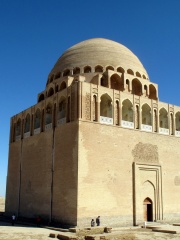

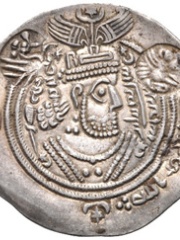
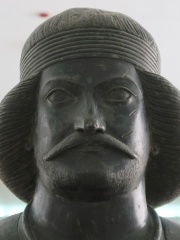
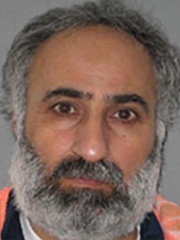
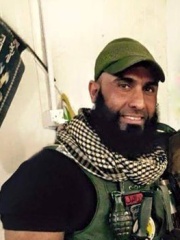


The Most Famous
MILITARY PERSONNELS from Iraq
This page contains a list of the greatest Iraqi Military Personnels. The pantheon dataset contains 2,058 Military Personnels, 9 of which were born in Iraq. This makes Iraq the birth place of the 31st most number of Military Personnels behind Sweden, and Belarus.
Top 9
The following people are considered by Pantheon to be the most legendary Iraqi Military Personnels of all time. This list of famous Iraqi Military Personnels is sorted by HPI (Historical Popularity Index), a metric that aggregates information on a biography's online popularity.

1. Ahmad Sanjar (1100 - 1157)
With an HPI of 75.52, Ahmad Sanjar is the most famous Iraqi Military Personnel. Her biography has been translated into 41 different languages on wikipedia.
Ahmad Sanjar (Persian: احمد سنجر; full name: Muizz ad-Dunya wa ad-Din Adud ad-Dawlah Abul-Harith Ahmad Sanjar ibn Malik-Shah) (6 November 1086 – 8 May 1157) was the Seljuq ruler of Khorasan from 1097 until 1118, when he became the Sultan of the Seljuq Empire, which he ruled until his death in 1157.

2. Qutayba ibn Muslim (668 - 715)
With an HPI of 70.05, Qutayba ibn Muslim is the 2nd most famous Iraqi Military Personnel. His biography has been translated into 25 different languages.
Abū Ḥafṣ Qutayba ibn Abī Ṣāliḥ Muslim ibn ʿAmr al-Bāhilī (Arabic: أبو حفص قتيبة بن أبي صالح مسلم بن عمرو الباهلي; 669–715/6) was an Arab commander of the Umayyad Caliphate who became governor of Khurasan and distinguished himself in the conquest of Transoxiana during the reign of al-Walid I (705–715). A capable soldier and administrator, he consolidated Muslim rule in the area and expanded the Caliphate's border to include most of Transoxiana. From 705 to c. 710, he consolidated Muslim control over the native principalities of Tokharistan and conquered the principality of Bukhara, while in 710–712 he conquered Khwarizm and completed the conquest of Sogdiana with the capture of Samarkand. The latter opened the road to the Jaxartes valley, and during the last years of his life Qutayba led annual campaigns there, extending Muslim control up to the Fergana Valley and parts of Chinese Turkestan. To increase his strained manpower, Qutayba initiated the wide-scale levy of native Khurasani and Transoxianian soldiers who fought alongside the Arab Muslim troops. Following Walid's death, Qutayba, insecure of his position under the new regime, rebelled but failed to secure the support of his army, and was killed. Most of his conquests in Transoxiana were lost in the years after his death; only in the 740s was the Muslim position restored to the line reached by Qutayba, and only after the Battle of Talas in 751 did the region come solidly under Muslim control.

3. Ubayd Allah ibn Ziyad (648 - 685)
With an HPI of 66.97, Ubayd Allah ibn Ziyad is the 3rd most famous Iraqi Military Personnel. His biography has been translated into 21 different languages.
Ubayd Allah ibn Ziyad (Arabic: عُبَيْدِ اللَّهِ بْنِ زِيَادٍ, romanized: ʿUbayd Allāh ibn Ziyād) was the Umayyad governor of Basra, Kufa and Khurasan during the reigns of caliphs Mu'awiya I (r. 661–680) and Yazid I (r. 680–683), and the leading general of the Umayyad army under caliphs Marwan I (r. 684–685) and Abd al-Malik (r. 685–705). He virtually inherited the governorships from his father Ziyad ibn Abihi after the latter's death in 673. During Ubayd Allah's governorship, he suppressed Kharijite and Alid revolts. In the ensuing Battle of Karbala in 680, Husayn ibn Ali and his small retinue were slain by Ubayd Allah's troops, shocking many in the Muslim community. Ubayd Allah is primarily remembered for his role in the killings of members of Ali ibn Abi Talib's family and he has become infamous in Muslim tradition. Ubayd Allah was ultimately evicted from Iraq by the Arab tribal nobility amid the revolt of Abd Allah ibn al-Zubayr. He made it to Syria where he persuaded Marwan I to seek the caliphate and helped galvanize support for the flailing Umayyads. Afterward, he fought at the Battle of Marj Rahit in 684 against pro-Zubayrid tribes and helped reconstitute the Umayyad army. With this army he struggled against rebel Qaysi tribes in the Jazira before advancing against the Alids and Zubayrids of Iraq. However, he was slain and his forces routed at the Battle of Khazir by Ibrahim ibn al-Ashtar, the commander of the pro-Alid Mukhtar al-Thaqafi of Kufa.

4. Surena (84 BC - 52 BC)
With an HPI of 65.17, Surena is the 4th most famous Iraqi Military Personnel. His biography has been translated into 29 different languages.
Surena or Suren, also known as Rustaham Suren (died 53 or 52 BC), was a Parthian spahbed ("general" or "commander") during the 1st century BC. He was the leader of the House of Suren and is best known for defeating the Romans at the Battle of Carrhae. Under his command, the Parthians decisively defeated a numerically superior Roman invasion force under the command of Marcus Licinius Crassus. It is commonly seen as one of the earliest and most important battles between the Roman and Parthian empires and one of the most crushing defeats in Roman history. "Suren" remains popular as a name in Iran and it is sometimes pronounced as "Soren". "Surena" is the Greek and Latin form of Sûrên or Sūrēn."Suren" also remains as a common name in Armenia. Suren means "the heroic one, Avestan sūra (strong, exalted)."
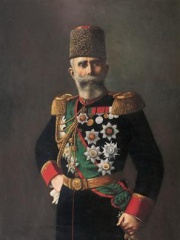
5. Mahmud Shevket Pasha (1856 - 1913)
With an HPI of 61.34, Mahmud Shevket Pasha is the 5th most famous Iraqi Military Personnel. His biography has been translated into 25 different languages.
Mahmud Shevket Pasha (Ottoman Turkish: محمود شوكت پاشا, Turkish: Mahmut Şevket Paşa; 1856 – 11 June 1913) was an Ottoman military commander and statesman. During the 31 March Incident in 1909, Shevket Pasha and the Committee of Union and Progress overthrew Abdul Hamid II after an anti-Constitutionalist uprising in Constantinople. He played the role of a military dictator, surpassing the power of the CUP and the Grand Viziers after the crisis, with many observers ascribing him the title "generalissimo". As War Minister he introduced military reform and the incorporation of Air Squadrons. Shevket Pasha became Grand Vizier during the First Balkan War, in the aftermath of the CUP's 23 January 1913 coup d'état, resuming war with the Balkan League. He was assassinated 6 months later by partisans of the Freedom and Accord Party, as part of a larger counter-coup attempt against the CUP.

6. Abu Ali al-Anbari (1957 - 2016)
With an HPI of 57.57, Abu Ali al-Anbari is the 6th most famous Iraqi Military Personnel. His biography has been translated into 18 different languages.
Abd al-Rahman Mustafa al-Qaduli (Arabic: عَبْدُ ٱلرَّحْمَٰنِ مُصْطَفَى ٱلْقَادُولِيِّ, romanized: ʿAbd ar-Raḥmān Muṣṭafā al-Qādūlī; 1 October 1959 – 18 March 2016), aka Abdullah bin Rashed al-Baghdadi, better known as Abu Ali al-Anbari (Arabic: أَبُو عَليِّ ٱلْأَنْبَارِيِّ, romanized: ʾAbū ʿAlī al-ʾAnbārī), was the governor for territories held by the Islamic State (IS) in Syria. Considered the IS second-in-command (along with Abu Muslim al-Turkmani, his counterpart in Iraq), he was viewed as a potential successor of IS leader Abu Bakr al-Baghdadi. On 14 May 2014, he was listed as a Specially Designated Global Terrorist by the U.S Treasury Department, and on 5 May 2015, the U.S. Department of State announced a reward of up to US$7 million for information leading to his capture or death. On 25 March 2016, the U.S. Department of Defense announced al-Qaduli’s death as a result of a US Special Operations helicopter gunship raid conducted earlier that week along the Iraq-Syria border.

7. Abu Azrael (b. 1978)
With an HPI of 50.47, Abu Azrael is the 7th most famous Iraqi Military Personnel. His biography has been translated into 17 different languages.
Ayoub Falih Hasan Al-Rubayie (Arabic: أيوب فالح حسن الربيعي; born 1978), known by his nom de guerre Abu Azrael, is an Iraqi commander in the Kataib al-Imam Ali, an Iraqi Shi'a militia group of the Popular Mobilization Forces that fought against the Islamic State (IS) in Iraq. He has become a public icon among Shia Iraqis, gaining a large following on social media. Abu Azrael was a member of Muqtada al-Sadr's Mahdi Army, which fought against the U.S.-led Coalition forces during the Iraqi insurgency.

8. Abu Hafs al-Hashimi al-Qurashi (b. 2001)
With an HPI of 47.23, Abu Hafs al-Hashimi al-Qurashi is the 8th most famous Iraqi Military Personnel. His biography has been translated into 20 different languages.
Abu Hafs al-Hashimi al-Qurashi (Arabic: أبو حفص الهاشمي القرشي, romanized: ʾAbū Ḥafṣ al-Hāshimī al-Qurashī) is the fifth and current caliph of the Islamic State. He was named as caliph on 3 August 2023, in an audio message by the spokesman of the IS, Abu Hudhayfah al-Ansari, whose announcement came four months after the death of his predecessor Abu al-Hussein al-Husseini al-Qurashi.

9. Juba (b. 1978)
With an HPI of 46.69, Juba is the 9th most famous Iraqi Military Personnel. His biography has been translated into 17 different languages.
Juba (Arabic: جوبا), sometimes spelled Joba, also known as Juba the Baghdad Sniper, is the pseudonym of an anonymous sniper with the Sunni insurgent group Islamic Army in Iraq involved in the Iraqi insurgency, featured in several videos released between 2005 and 2007. Juba became famous after videos showing footage of his shootings appeared online. The second of these videos shows Juba marking a tally of 37 "kills". Juba became a folk hero among many Iraqis due to his role in fighting against the American occupation of Iraq. Juba worked in mostly Sunni parts of Iraq, specifically the Al Anbar province. Juba's videos showed real battle scenes with background nasheeds. In many videos, Juba is seen killing and wounding multiple American soldiers with what seems to be a Dragunov sniper rifle. Juba is seen wounding and killing at ranges of a few hundred meters (yards) to approximately a thousand meters (yards) in the videos, several of them involving precision shots to the head. Juba waits for U.S. soldiers to dismount, or stand up in a Humvee turret, and aims for gaps in their body armor, the lower spine, ribs, or above the chest. There have been speculations that Juba is not one person but multiple snipers working under a pseudonym. The number of kills Juba claimed has also been debated as not all were verified. The IAI statistics claims that from 2005 to 2006 (1426 AH to 1427 AH) that the sniper brigade had killed 634 American soldiers, 23 military officer, 11 American snipers and wounded 206 American soldiers. However, according to sniper expert and Vietnam War veteran, John Plaster, Juba may have killed around 143 American service members.
People
Pantheon has 9 people classified as Iraqi military personnels born between 84 BC and 2001. Of these 9, 3 (33.33%) of them are still alive today. The most famous living Iraqi military personnels include Abu Azrael, Abu Hafs al-Hashimi al-Qurashi, and Juba. The most famous deceased Iraqi military personnels include Ahmad Sanjar, Qutayba ibn Muslim, and Ubayd Allah ibn Ziyad. As of April 2024, 1 new Iraqi military personnels have been added to Pantheon including Abu Hafs al-Hashimi al-Qurashi.
Living Iraqi Military Personnels
Go to all RankingsAbu Azrael
1978 - Present
HPI: 50.47
Abu Hafs al-Hashimi al-Qurashi
2001 - Present
HPI: 47.23
Juba
1978 - Present
HPI: 46.69
Deceased Iraqi Military Personnels
Go to all RankingsAhmad Sanjar
1100 - 1157
HPI: 75.52
Qutayba ibn Muslim
668 - 715
HPI: 70.05
Ubayd Allah ibn Ziyad
648 - 685
HPI: 66.97
Surena
84 BC - 52 BC
HPI: 65.17
Mahmud Shevket Pasha
1856 - 1913
HPI: 61.34
Abu Ali al-Anbari
1957 - 2016
HPI: 57.57

